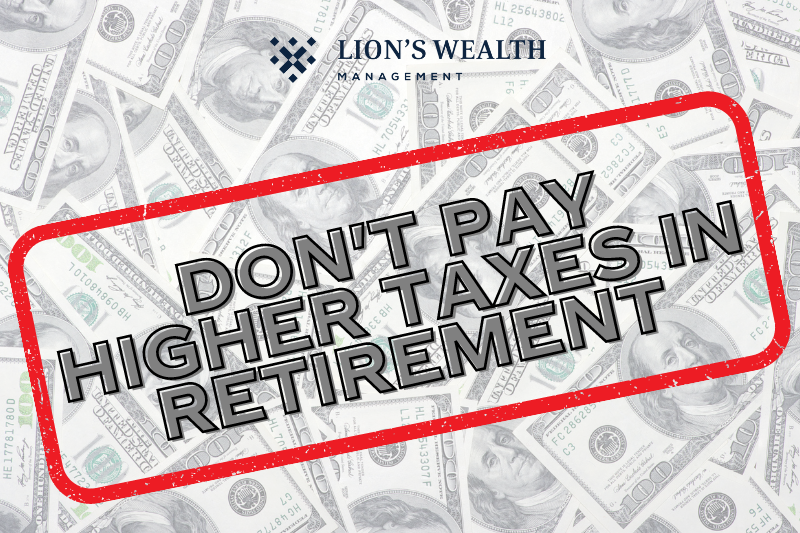We are as a society in terms of how taxes and the tax code will likely change our future financial lives. We have a short runway to do something about it right now, but the end of that runway is quickly approaching.
Today’s retirees have possibly more money than any previous generation – and this could mean they’ll also pay the most in taxes. This generation of retirees has a substantial amount saved in tax-deferred retirement accounts as well as other taxable assets, which means they shouldn’t assume they’ll pay much less in taxes in retirement. There are a few reasons, including changing tax policy and required minimum distributions. Plan for the taxes of tomorrow!
Here’s the different Tax Buckets
Tax-Deferred Account/Savings Plan
A tax-deferred savings plan is an investment account that allows a taxpayer to postpone paying taxes on the money invested until it is withdrawn, generally after retirement. The best-known such plans are individual retirement accounts (IRAs) and 401(k)s.
Tax-deferred savings plans are qualified by the Internal Revenue Service (IRS) and allow the taxpayer to pay money into the plan and subtract that amount from their taxable gross income for that year. The taxes on the contribution and its investment returns will be due only when the money is withdrawn, generally after the taxpayer retires.
For IRAs, contributions to traditional IRAs are tax deductible, with some income limitations if the taxpayer or their spouse has a retirement plan at work.
Contributions to Roth IRAs are not tax deductible, and there are income limits on who may contribute to a Roth IRA.
However, money held in both types of IRAs grows tax free until it is withdrawn.
Benefits of Tax-Deferred Plans
The tax-deferred savings plan was approved by the federal government as a way to encourage Americans to save for retirement. An individual may contribute a portion of pretax earnings to an investment account.
There are several benefits to the individual:
Each year’s taxable earned income is reduced by the amount contributed to the account. This lowers the federal taxes owed by the individual for that year.
The money is then invested in the individual’s choice of mutual funds or other types of investments, with a balance that grows steadily until retirement. The pretax money boosts the amount invested and its potential growth over time.
After retiring, the individual can draw from the fund for income.
Tax Free Account/Roth IRA
Similar to other qualified retirement plan accounts, the money invested within the Roth IRA grows tax-free. However, a Roth IRA is less restrictive than other accounts.
The account holder can maintain the Roth IRA indefinitely; there are no required minimum distributions (RMDs) during their lifetime, as there are with 401(k)s and traditional IRAs.
A Roth IRA is a type of tax-advantaged individual retirement account to which you can contribute after-tax dollars. The primary benefit of a Roth IRA is that your contributions and the earnings on those contributions can grow tax-free and be withdrawn tax-free after the age 59½ assuming the account has been open for at least five years.
Roth IRAs are similar to traditional IRAs, with the biggest distinction being how the two are taxed. Roth IRAs are funded with after-tax dollars—this means that the contributions are not tax-deductible, but once you start withdrawing funds, the money is tax-free.
Conversely, traditional IRA deposits are generally made with pretax dollars; you usually get a tax deduction on your contribution and pay income tax when you withdraw the money from the account during retirement.
Life Insurance
Life insurance is something you may consider adding to your financial plan if you’re interested in providing a measure of security for your loved ones. Proceeds from a life insurance policy can be used to pay final expenses, eliminate outstanding debts, or cover day-to-day expenses. Whether life insurance is a smart investment may depend on what you need and want a policy to do for you.
When deciding whether life insurance is a good investment, it’s important to understand the types of policies you can purchase. There are several variations of life insurance plans, but they generally fall into two categories: permanent and term.
Tom Hegna says there is a better way to give your children an inheritance than leaving them money: Use life insurance.
Annuitity
The term “annuity” refers to an insurance contract issued and distributed by financial institutions with the intention of paying out invested funds in a fixed income stream in the future. Investors invest in or purchase annuities with monthly premiums or lump-sum payments. The holding institution issues a stream of payments in the future for a specified period of time or for the remainder of the annuitant’s life. Annuities are mainly used for retirement purposes and help individuals address the risk of outliving their savings.
What can you do?
Rather than wait and watch, you can act. Create a long-term tax-minimization strategy and plan for the tax rates of the future, not the rates of today. There are numerous strategies to help minimize taxes on your retirement income, as well as your estate, and a professional like us can walk you through them.








